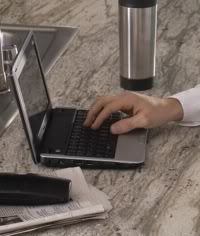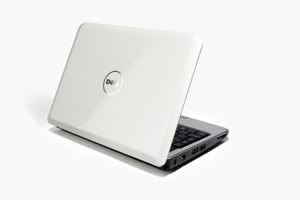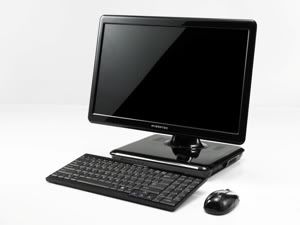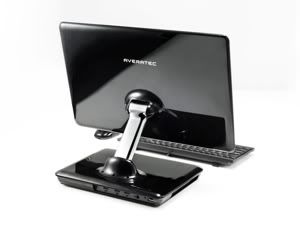Dell Mini 9
One of the hottest whims in the personal computer market over the last year has been the “ netbook.” (More on netbooks here.)
While the common perception has always been that personal computers should continually grow bigger and more powerful, netbooks have completely defied the marketplace by offering smaller computers with low power. While most traditional laptops today have a screen size between 13″ and 15″ and weigh anywhere from 5lbs. to 12 lbs., most netbooks have screen sizes of 10″ and usually weigh under 3lbs. (with some closer to 2lbs.).
 One of the smallest netbooks has been the Dell Mini 9, which as you can presume from the name, has a screen size of only 9 inches. That means when the computer is closed, it’s about the size of a paperback novel.
One of the smallest netbooks has been the Dell Mini 9, which as you can presume from the name, has a screen size of only 9 inches. That means when the computer is closed, it’s about the size of a paperback novel.
At the end of May 2009, Dell decided to discontinue the Dell Mini 9 and replace it with a 10″ model. This review will focus on the Dell Mini 9 (now I guess a collector’s item best found on eBay), but most of the information can be applied to Dell’s 10″ model and other netbooks.
[Late Update: It appears that Dell has brought the Dell Mini 9 back at least temporarily according to Engadget.]
The best feature of the Dell Mini 9 is its portability. The worst feature of the Dell Mini 9 is the keyboard (which has been improved greatly in the Dell Mini 10). In order to achieve the incredibly small form factor, something had to give, and it was the keyboard that suffered.
Everything about the Dell Mini 9 is built for portability. The unit is easy to carry, easy to open, and can fit just about anywhere, including the tray table on the airline seat in front of you (imagine!).
Dell did a good job designing the Mini 9 which offers an SD memory card slot along with a total of three USB slots. You also have an Ethernet port, although most people elect to simply use the built-in wireless functionality. Some models also feature Bluetooth connectivity.
As I eluded above, netbooks like the Dell Mini 9 are underpowered and have limited storage capacity. After all, the whole idea of the “netbook” is that most of the work you’re going to be doing is over the internet.
The Dell Mini 9 uses an Intel processor specifically designed for netbooks that runs at a much lower speed than anything you’ll find in a “traditional” laptop. Most of the Dell Mini 9 models only came with 512MB of RAM, although some now can go as high as 1GB or 2GB.
One of the best features of the Dell Mini 9 is that the hard drive is based on solid state technology (commonly referred to as “SSD” for “solid state drives”). While typical hard drives still have spinning platters, solid state hard drives feature no moving parts and are based on the same technology as what you would find in a USB memory key or the digital memory card that you insert into your digital camera.
Solid state hard drives require less power to run than traditional drives which means netbooks typically boast longer battery run-times. The flipside, however, is that solid state drives offer much smaller capacities than their typical hard drive cousins (at least for now). While the original Dell Mini 9 models featured only 4GB worth of storage space, you can get upwards of 32GB or 64GB today – a paltry amount of storage compared to most modern personal computers.
 The pricepoint for the Dell Mini 9 was between $250 and $400, which makes it appealing as an second, additional computer for the house or office (the Dell Mini 10 starts at $299). I’ve found myself taking the Dell Mini 9 to the couch while I’m watching TV, or a perfect companion for getting work done on a plane (did I mention that I can actually open it up on a the tray in front of me? Imagine!).
The pricepoint for the Dell Mini 9 was between $250 and $400, which makes it appealing as an second, additional computer for the house or office (the Dell Mini 10 starts at $299). I’ve found myself taking the Dell Mini 9 to the couch while I’m watching TV, or a perfect companion for getting work done on a plane (did I mention that I can actually open it up on a the tray in front of me? Imagine!).
Be aware that all Dell Minis, and most netbooks, have sacrificed the CD/DVD optical drive for the sake of making the computer smaller. This is usually not a problem since there are plenty of USB ports to handle memory keys and external hard drives. When I need to install an application on a CD, I usually copy the contents to a USB memory key. Watching DVDs only works if you can copy the movie to the hard drive, which is not always easy thanks to copyright restrictions and digital rights management. You can always purchase an external, USB powered CD/DVD optical drive, but that’s another piece of hardware to carry.
The original Dell Mini computers were sold with an open source version of the Linux Operating System (usually Ubuntu) instead of the more costly Microsoft Windows. You won’t find a netbook successfully running Windows Vista (requires more power), but most netbooks can certainly run Windows XP. Unless you’re familiar and comfortable with Linux, I would recommend paying a little bit more to get Windows XP.
While I have grown very fond of my Dell Mini 9, I continue to have a huge problem with the keyboard. In order to make everything fit into the small form factor, Dell had to make shrink some keys and move other keys from their traditional spots. Most notably for me is the right shift key and the apostrophe – both have been moved to unnatural, impossible positions, which means I consciously type without capitalizing or any apostrophes to save time from all the corrections I would have to make.
That sounds like a deal-breaker, and it would be if this were my primary computer. As it turns out, the Dell Mini 9 has become my “real” portable computer when I’m on the go, and so I’m only checking e-mail, surfing Websites, and reading documents on it most of the time – all tasks that don’t demand a lot of typing.
I’ve found that the Dell Mini 9 has found a nice sweet spot between my regular, 15″ laptop and my smartphone. When I don’t want to get out my larger laptop, and the screen on my smartphone is too small, the Dell Mini 9 is perfect.
Averatec All-In-One PC 18.4″
 The netbook craze is not for everyone, so I have another compact, “all-in-one” computer to offer in review.
The netbook craze is not for everyone, so I have another compact, “all-in-one” computer to offer in review.
One of the most popular all-in-one desktop PCs is the iMac from Apple. The iMac is sleek, beautiful and has a minimal number of wires. The entire computer is built into the back of the LCD screen and if you use a wireless keyboard and mouse you really only have the power cord to deal with.
Some PC manufacturers have attempted to duplicate the success of the iMac by creating their own version of the all-in-one PC and I’m happy to be reviewing one of these models from computer manufacturer Averatec (global brand of TriGem).
Averatec is better known for their laptops and other smaller computers over the years but they’ve made an interesting push into the all-in-one market with a couple of 18.4 inch models as well as a 22 and 25 inch model. For this review, I looked at the low-end (18.4 All-in-one model) which I believe holds more than enough power for most activities in a law practice.
The 18.4 inch Averatec All-in-one desk top PC looks good on just about any desk top. Instead of an bulky, ugly beige box that sits on the floor, the entire computer fits inside an approximately 8½ x 11 inch base sitting under the LCD monitor.
The monitor is big, bold and beautiful encased in glossy black plastic sitting on top of a silver arm. The base of the all-in-one houses the power button, brightness adjustments, volume controls, the USB ports and the CD/DVD drive. The Averatec All-in-one comes with a wired keyboard and a wired mouse, but you may want to consider purchasing a wireless keyboard and mouse combo to keep the wires down to a minimum.
 The Averatec All-in-one can be plugged into an Ethernet network but it includes built-in wireless so that the unit can be placed anywhere and still get access to the internet. For such a nice-looking computer one would expect to pay a little bit more than the current price tag of around $499, but Averatec kept the price low by incorporating lower-cost, lower-powered innards.
The Averatec All-in-one can be plugged into an Ethernet network but it includes built-in wireless so that the unit can be placed anywhere and still get access to the internet. For such a nice-looking computer one would expect to pay a little bit more than the current price tag of around $499, but Averatec kept the price low by incorporating lower-cost, lower-powered innards.
That’s not a bad thing. There’s always the perception that you need to buy the most powerful computer with the most hard drive space and the most RAM. But in most law practices, we barely use a fraction of the total processing power available in most of the computers that sit on the desk of legal professionals. In the “real-world,” the biggest hogs on processing power are video-editing and high-powered games, neither of which usually happens at a law office. If you are engaging in those computing activities, you’ll need to visit the bank for a little more spending cash.
The Averatec All-in-one closely resembles a netbook in the skin of a desktop PC. The processor used inside Averatec’s All-in-one is very similar to the processors found in many netbooks. That means the All-in-one can ably handle typical office applications such as Microsoft Word and Outlook, and it can certainly surf the Internet without a problem. Because of the lower-end processor, the Averatec will only run Windows XP, since there is not enough power for the more demanding Windows Vista.
I thoroughly enjoyed using the Averatec 18.4 inch All-in-one because it looked great and the screen was more than acceptable. There is nothing really all that spectacular about the Averatec All-in-one except for the fact that it fits much better into a tight spot and you don’t have to worry about all the wires that come with hooking up a separate monitor, the Ethernet cables, sound cables and everything else. Averatec did a very nice job of designing the line of All-in-one PCs so that it literally has all components built into one little small form factor.
